VITACILINA® Bebé Diaper Rash Ointment
skin protectant & rash ointment • For 0-6 month old infants • Skin contact 🧴
Product Images
Product Photo

Tap to enlarge
Ingredient List

Tap to enlarge
Is this safe for 0-6 month old newborns to use VITACILINA® Bebé Diaper Rash Ointment?
Check for Different Age (6 available)
Ingredients Analysis (9 found)

































Common Questions About VITACILINA® Bebé Diaper Rash Ointment
Is this newborn-safe? VITACILINA® Bebé Diaper Rash Ointment
VITACILINA® Bebé Diaper Rash Ointment is not recommended for 0-6 month old babies due to potentially harmful ingredients.
What ingredients should I watch out for?
We analyzed 9 ingredients in VITACILINA® Bebé Diaper Rash Ointment. 1 avoid, 2 concerning, 3 caution. Check the detailed analysis above for specific concerns.
When can newborns start using skin protectant & rash ointment?
The appropriate age depends on the specific ingredients. This analysis is for 0-6 month old babies. Use the age selector above to check other ages.
⚠️ Important Disclaimers
Product Recognition: Product names are identified programatically and may be incorrect. Always verify product identity yourself.
Safety Analysis: Evaluations are for research only - consult pediatricians for medical decisions. Do not rely solely on this analysis.
No Guarantees: Results may be incomplete or inaccurate. Do not rely solely on this analysis.